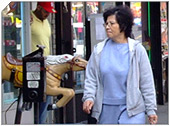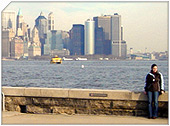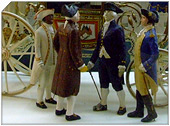Getting Started
Index
NYC Neighborhoods
Manhattan
Brooklyn
Queens
Bronx
Staten Island
NYC Icons
Chrysler Building
Flatiron Building
Empire State Building
Safe NYC
NYPD
FDNY
NYC Weather
NYC Climate
NYC Weather Forecast
Winter Season
Spring Season
Summer Season
Fall Season
NYC History & Politics
New York City History
Tammany Hall and Politics
New York City Politicians
New York City Personalities
Culture of Gotham City
Culture of the city
Cultural diversity
City in popular culture
|
Christopher George Latore Wallace (May 21, 1972 - March 9, 1997), popularly known as Biggie Smalls (after a gangster in the 1975 film Let's Do It Again), Big Poppa, Frank White (from the film King of New York), and his primary stage name, The Notorious B.I.G. (Business Instead of Game), was an American rapper and hip hop artist.
Born in Brooklyn, New York, Biggie grew up during the peak years of the 1980s crack epidemic and started dealing drugs from an early age. When he debuted with the 1994 album Ready to Die, he was a central figure in East Coast hip-hop and increased New York's viability at a time when the genre was mostly dominated by West Coast artists. The following year, Biggie led his childhood friends to chart success through his protégé group, Junior M.A.F.I.A.
While recording his second album, Biggie was heavily involved in the East Coast-West Coast hip hop feud dominating the scene at the time. On March 9, 1997, he was killed by an unknown assailant in a drive-by shooting in Los Angeles. His double-disc set Life After Death, released fifteen days later, hit #1 on the U.S. album charts and was certified diamond in 2000. Biggie was noted for his "loose, easy flow", dark semi-autobiographical lyrics and storytelling abilities. Since his death, a further two albums have been released and he has been described by the media as one of the greatest rappers.
Carieer
Biggie was born in the Bedford-Stuyvesant section of Brooklyn, New York. He was the only child to Voletta Wallace, a pre-school teacher of Jamaican origin and George Letore, a welder and small-time Jamaican politician. His father left the family when Biggie was two years old, leaving his mother to work two jobs while raising him. At the Queen of All Saints Middle School, Biggie was a good student, winning several awards as an English student. He was nicknamed "Big" because of his size before he turned ten years old. From the age of twelve, he sold drugs, unbeknownst to his mother.
Biggie transferred out of the private Roman Catholic school that he attended, at his request, to attend the state-funded George Westinghouse Information Technology High School, where Jay-Z and Busta Rhymes were also students. According to his mother, he was still a good student, but developed a "smart-ass" attitude. At 17, Biggie dropped out of high school and became further involved in crime. In 1989, he was arrested on weapons charges in Brooklyn and sentenced to five years' probation. In 1990, he was arrested on a violation of his probation. A year later, Biggie was arrested in North Carolina for dealing crack cocaine. He spent nine months in jail until he made bail.
Biggie started rapping from a young age, performing with local groups, the Old Gold Brothers and the Techniques. After leaving prison, he made a demo tape under the name of Biggie Smalls, a reference to his childhood nickname and to his stature; he stood at 6'3" (1.90 m) and weighed between 300 and 380 pounds (between 136 and 172 kg) by differing accounts. The tape was reportedly made with no serious intent on getting a recording deal, but was promoted by New York-based DJ Mister Cee, who had previously worked with Big Daddy Kane, and was heard by the editor of The Source magazine.
In March 1992, Biggie featured in The Source's Unsigned Hype column, dedicated to aspiring rappers and was invited to produce a recording with other unsigned artists, in a move that was reportedly uncommon at the time. The demo tape was heard by Uptown Records A&R and producer, Sean "Puffy" Combs, who arranged for a meeting with Biggie. He was signed to Uptown immediately and made an appearance on label mates, Heavy D & the Boyz' "A Buncha Niggas" (from Blue Funk).
Soon after signing his recording contract, Combs was fired from Uptown and started a new label. Biggie followed and in mid 1992, signed to Combs' new imprint label, Bad Boy Records. On August 10, 1992 Biggie's long-term partner gave birth to his first child, T-yanna. Biggie continued selling drugs after the birth to support his daughter financially. Once this was discovered by Combs, he was made to quit.
Biggie gained exposure later in the year on a remix to Mary J. Blige's single "Real Love", under the pseudonym The Notorious B.I.G.; the name he would record under for the remainder of his career after finding his original moniker was in use. "Real Love" peaked at #7 on the Billboard Hot 100 chart and was followed by a remix of Blige's "What's the 411".
He continued this success, to a lesser extent, on remixes with Neneh Cherry ("Buddy X") and reggae artist Supercat ("Dolly My Baby", also featuring Combs) in 1993. In April 1993, his solo track, "Party and Bullshit", appeared on the Who's the Man? soundtrack. In July 1994, he appeared alongside LL Cool J and Busta Rhymes on a remix to label mate Craig Mack's "Flava in Ya Ear", reaching #9 on the Hot 100. In the same year, Biggie collaborated on "Runnin'" and other songs with rapper Tupac Shakur, a New York City native who he met in Los Angeles.
|
New York City Search
Quick NYC
|



 New York Weather Forecast
New York Weather Forecast
 Ethnic composition
Ethnic composition


















